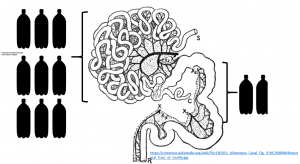32 SI activity and function
SI Activity
The activity of the SI is highly controlled by the enteric nervous system. The interneurons in the myenteric nervous plexus carefully coordinate a timed and sequential relaxation and contraction that pushes the bolus of food aborally. In the small intestine, food should only move in one direction – retrograde flow is not normal. Mixing in place does occur.
Patterns of small intestinal motility are regular – moving from periods of no spiking activity of the neurons (no contraction), through intermittent spiking/ contraction and through to regular spiking and contraction. The regular spiking phase helps to clear the contents by a more forceful peristaltic wave.
SI function
The small intestine does most of the work. It is responsible for the majority of fluid absorption as well as for nutrient digestion and absorption.
The anatomical structure of the villi and microvilli is essential for efficient nutrient absorption. The normal structure works to uptake nutrients via the short diffusion path, active transportation mechanisms, and concentration gradients. Changes in the microvilli structure can impair nutrient absorption and lead to fluid loss.
The bile and pancreatic ducts empty into the duodenum, providing the needed factors for fat, carbohydrate and protein digestion. More protein and disaccharide digestion occurs by enzymes released from the enterocytes. The intestinal wall also maintains a firm border to keep out the bacteria and larger components found in the ingesta. Maintaining this tight wall also permits active transport mechanisms to exist by allowing electrolytes to stay in unequal concentrations (not go down the concentration gradient).
The duodenum also helps regulate gastric, liver and pancreatic functions. Secretory function is high with a large volume of fluid added to the ingesta in the proximal SI.
Secretin is released from duodenal S cells when acid levels are high in the duodenum. Secretin stimulates bicarbonate production and release from the pancreas. Secretin also decreases gastrin production, slows gastric emptying and inhibits bile release.
CCK (cholecystokinin) is released from enteroendocrine cells when protein and fat byproducts are identified in the duodenum. CCK stimulates bile release, pancreatic enzyme release and more bicarbonate secretion.
| Hormone | Primary Action | Stimulus | Source |
| Gastrin | Releases HCl and stimulates gastric mucosal growth | Calcium and peptides in the stomach | G cells in gastric pits |
| Cholecystokinin (“to move the gall bladder” | Stimulates release of pancreatic enzymes and bile | Partially digested fats and proteins in duodenum | Duodenal enteroendocrine cells |
| Secretin | Releases bicarbonate rich fluid from pancreas. Inhibits gastrin production | Acidification of the duodenum | Duodenal S cells |
Different parts of the gut have different functions, including different amounts of water absorption. All species primarily absorb water from the small intestine. Hindgut fermenters (horses) can also absorb quite a bit from the LI. If the total body water content becomes too low, more water is absorbed from the colon, making the stool even drier. Stool that is retained in the colon will also become dry. Astute animal owners can detect changes in their pet through changes in the stool size and consistency.
Water absorption

Osmosis is the main force behind water movement. By using active transport pumps, the levels of sodium and glucose are higher in the blood than in the gut lumen. This creates a concentration gradient that permits osmosis (movement of water).
Resources
Vivo CSU site– more enzymes if you like this stuff (or want to review these)
Water movement– video
Integrated function – the intestinal phase – includes crypt cell function and general overview
Secretion in the small intestine- another briefer look at secretory action
Just for fun
Intestines peristalting (not a real word) video

